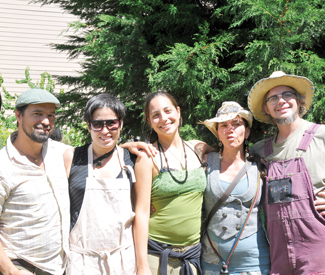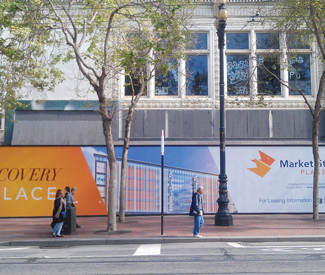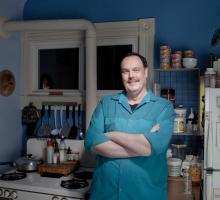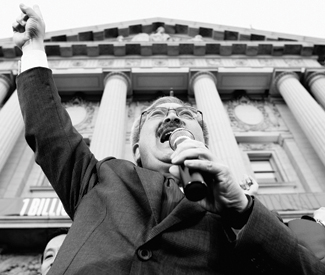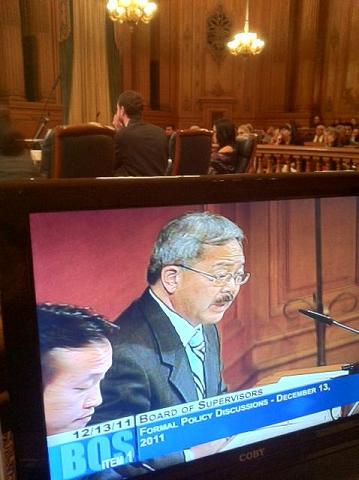Stage listings are compiled by Guardian staff. Performance times may change; call venues to confirm. Reviewers are Robert Avila, Rita Felciano, and Nicole Gluckstern. Submit items for the listings at listings@sfbg.com. For further information on how to submit items for the listings, see Picks.
THEATER
ONGOING
Cat on a Hot Tin Roof Buriel Clay Theater at the African American Art and Culture Complex, 762 Fulton, SF; www.african-americanshakes.org. $10-15. Sat/16, 8pm; Sun/17, 3pm. African-American Shakespeare Company performs Tennessee Williams’ Pulitzer-winning classic.
Dear Harvey New Conservatory Theatre Center, 25 Van Ness, SF; www.nctcsf.org. $25-45. Wed-Sat, 8pm; Sun, 2pm. Through Feb 24. There’s always room in San Francisco for milk — Harvey Milk, that is, our very own out-and-proud crusader for equal rights for all, whose election as city supervisor in 1977 and assassination in 1978 galvanized the LGBT movement on a national level. Part history lesson, part memorial tribute, the Patricia Loughrey-penned Dear Harvey offers details of the extent of his influence, mostly in the realm of the political, collected from interviews with over 30 of Milk’s associates and friends. Interspersing testimonials with Bay Area Reporter headlines, fan mail, and projections of Daniel Nicoletta’s candid photos of the era, each member of the ensemble cast assumes multiple roles throughout the piece including Harvey’s activist nephew Stuart Milk, the "Queen Mother of the Americas" Nicole Murray-Ramirez, openly-gay politician Tom Ammiano, former youthful aide and prominent AIDS activist Cleve Jones, Milk’s spitfire campaign manager Anne Kronenberg, and even Milk himself. At its core, Dear Harvey plays out mainly like a talking head-style documentary, the disparate strands of monologue woven together providing a composite image of a single character. But as endearing in many ways that character is, it’s not enough to sustain the overall piece, which never develops its other, often fascinating, characters enough for the audience to feel much of a connection to the stage, no matter how much, personally, they might feel a connection to Milk himself. (Gluckstern)
Foodies! The Musical Shelton Theater, 533 Sutter, SF; www.foodiesthemusical.com. $30-34. Fri-Sat, 8pm. Open-ended. AWAT Productions presents Morris Bobrow’s musical comedy revue all about food.
God of Carnage Shelton Theater, 533 Sutter, SF; www.sheltontheater.org. $38. Thu-Sat, 8pm. Through March 30. Shelton Theater presents Yasmina Reza’s Tony-winning comedy about upper-middle-class parents clashing over an act of playground violence between their children.
Hedwig and the Angry Inch Boxcar Playhouse, 505 Natoma, SF; www.boxcartheatre.org. $25-40. Wed-Sat, 8pm (also Sat, 5pm). Through March 2. Hold onto your hairpiece, Boxcar Theatre is reprising their all-too short summer run of Hedwig and the Angry Inch, and just in case you think you saw it already, be forewarned — you ain’t seen nothing yet. Recast, redesigned, and re-vamped, this outcast-rock musical familiarly follows the misadventures of one Hedwig Robinson (né Hansel Schmidt) with glam, guts, and glitter. But unlike the movie version penned by and starring John Cameron Mitchell as the titular chanteuse, or other staged versions, director Nick A. Olivero splits the larger-than-life, would-be rock sensation into eight different characters, who are each given a solo turn as well as plenty of ensemble harmonizing during the course of the two hour-plus performance. The effect is often electric, and just as frequently hilarious, as when the four female actors playing the role stomp across the stage swinging imaginary dicks in the air to the lyric "six inches forward and five inches back, I got a, I got an angry inch!" Supported by a tight quartet of rock musicians led by Rachel Robinson, and the phenomenal Amy Lizardo as Hedwig’s beleaguered "man Friday" Yitzhak, Hedwig keeps on extending for what appears to be an indefinite run, employing the time-honored Thrillpeddlers’ tradition of rotating cast members and comeback performances, which means you could theoretically go multiple times and never see quite the same show twice. I certainly plan to. (Gluckstern)
Jurassic Ark Exit Theatre, 156 Eddy, SF; www.theexit.org. $15-25. Fri-Sat, 8pm. Through March 16. Writer-performer David Caggiano’s zany, well-executed solo play centers on a Christian televangelist who is unwaveringly bent on making a big-budget movie about a cowboy-like Biblical Noah, his Ark, and the largely lovable dinosaurs callously left out of the story — a project he sees delivering a decisive blow to the Darwinians, while turning cineplexes across the land into celluloid cathedrals. Brother Dallas and his proselytizing pitch eventually find receptive ears in a trinity of movie-industry heavies, whose collective business acumen demands a few changes to the script. Meanwhile, the intoxicating power of it all leads to a lapse in Brother Dallas’s righteousness and a scandal reminiscent of Hugh Grant’s career. Dallas rebounds from this bout with the Devil and sees his movie made — but surely only he is unaware that the Devil keeps a Hollywood address. Smartly directed by Mark Kenward, this low-frills production relies almost exclusively on Caggiano’s sturdy ability with quick-change characterizations (couched in Dylan West’s modest lighting design and a suggestive soundscape by sound editor–musician John Mazzei). The fitful satire trades in pretty orthodox caricature and, in Brother Dallas, lacks a very compelling or sympathetic central figure; but it unfolds with a very cinematic imagination that, while formulaic, is itself one hell of a movie pitch. (Avila)
The Little Foxes Tides Theatre, 533 Sutter, SF; www.tidestheatre.org. $20-38. Wed-Sat, 8pm. Through Feb 23. Tides Theatre Company performs a modern take on the Lillian Hellman classic.
Se Llama Cristina Magic Theatre, Fort Mason Center, Marina at Laguna, SF; www.magictheatre.org. $22-60. Wed/13-Sat/16, 8pm (also Wed/13, 2:30pm); Sun/17, 2:30pm. Magic Theatre performs the world premiere of Octavio Solis’ multi-layered drama.
Manic Pixie Dream Girl ACT Costume Shop Theater, 1117 Market, SF; www.manicpixiedreamgirl.org. $25-35. Extended run: Thu/14-Sun/17, 8pm. Billed as a "graphic-novel" play, first-time playwright Katie May’s Manic Pixie Dream Girl reaches out to a demographic frequently left out of the theatrical conversation — the geek chic, 20-something set. Marrying projected panels of black-and-white graphic novel-style drawings with dialogue and action provided by the actors onstage, this PlayGround co-production attempts to combine two very different mediums into a smooth narrative, a rocky but valiant effort. Much of the live action appears cartoonish rather than nuanced, and the two central protagonists — struggling painter and wannabe graphic novel artist Tallman (Joshua Roberts) and his new muse Lilly (Lyndsy Kail), a waifish mute with pockets full of candy wrappers chance-met in his neighborhood dive bar — are awkwardly incomplete ciphers. If you’re looking for the depth of detail and the visual impact of a Transmetropolitan or a Berlin, you won’t find it in MPDG, but what you will get is a glad eyeful of Rob Dario’s striking graphics, and some impeccable support acting courtesy of Lucas Hatton (who plays several welcome roles including a buttinsky, bro of a bartender and a "evil" real estate agent with all the charm and smarm of an overgrown frat boy), Liz Anderson’s bitch-queen supernova ex-girlfriend, and Michal Barrett Austin’s winsome cynicism as Tallman’s best buddy. (Gluckstern)
The Motherfucker with the Hat San Francisco Playhouse, 450 Post, SF; www.sfplayhouse.org. $30-70. Tue-Thu, 7pm; Fri-Sat, 8pm (also Sat, 3pm). Through March 16. A fine cast makes the most of Stephen Adly Guirgis’s deceptively coarse, often amusing little play, The Motherfucker with the Hat, which receives its local premiere in a sure and rowdy production from SF Playhouse. Director and designer Bill English’s striking two-tier set almost belies the intimate nature of the quirky story, which concerns a hapless parolee and recovering alcoholic named Jackie (a winningly frazzled, bumptious Gabriel Marin) who retreats to his AA sponsor’s apartment to pine and plot revenge after he discovers a stranger’s hat in the bedroom of his longtime Puerto Rican girlfriend, Veronica (played vividly by an at once edgy and vulnerable Isabelle Ortega). But Ralph, his suave and persuasive sponsor (played with unctuous charm gilded by just a hint of ineptitude by an excellent Carl Lumbly), may not be the guy he wants in his corner. Not that Jackie can see that — he’s got a man-crush on Ralph that dwarfs his already ambivalent affection for much put-upon but stalwart cousin Julio (a sharply funny Rudy Guerrero) and blinds him to the warning signals from Ralph’s own disgruntled wife (a coolly disgusted Margo Hall). Throughout, these working-class New York borough dwellers display their wit and shield their soft underbellies with a rapid-fire barrage of creative swearing. English and cast display a real comfort with this kind of material (this is SF Playhouse’s fourth Girguis play), which drapes its soft heart in the intimations of violence more than the real thing. If the heat and imaginative cursing also seem to cover up for a play with little dramatic purpose beyond a gentle and somewhat pat exploration of loyalty, maturity, and trust, there’s pleasure to be had in the unfolding. (Avila)
Not a Genuine Black Man Marsh San Francisco, 1062 Valencia, SF; www.themarsh.org. $25-50. Fri, 8pm; Sat, 5pm. Through Feb 23. What, the unapologetically middle-class Brian Copeland asks, is the real meaning behind the phrase "a genuine black man"? By way of an answer, the stand-up comic and KGO radio host offers up a simultaneously funny and disarmingly frank story about growing up African American in the racist suburb that was San Leandro in the early 1970s. Letting his narrative bounce back and forth between his boyhood memories and a period of depression that overtook him as a parent in 1999 — and interlacing the autobiography with verbatim utterances from both sides of the fight his family joined to desegregate the city — Copeland brings admirable chops as a comedian to bear on some difficult and disturbing, if ultimately hopeful, material. Note: review from an earlier run of the same show. (Avila)
Sex and the City: LIVE! Rebel, 1760 Market, SF; trannyshack.com/sexandthecity. $25. Wed, 7 and 9pm. Open-ended. Lady Bear, Trixie Carr, Heklina, and D’Arcy Drollinger star in this drag tribute to the long-running HBO show.
The World’s Funniest Bubble Show Marsh San Francisco, 1062 Valencia, SF; www.themarsh.org. $8-50. Sun, 11am. Extended through March 17. The Amazing Bubble Man (a.k.a. Louis Pearl) continues his family-friendly bubble extravaganza.
You Know When the Men Are Gone Z Space, 450 Florida, SF; www.zspace.org. $30-55. Wed-Thu, 7pm; Fri-Sat, 8pm; Sun, 3pm. Through Feb 24. Word for Word mounts two related short stories from the titular collection by Siobhan Fallon about the home-front impact of warfare on the families of an American army base. In The Last Stand, an injured soldier (Chad Deverman) returns home to his young wife (Roselyn Hallett) to find she has decided to leave him. In Gold Star, a wife (Arwen Anderson) learns of her soldier husband’s (Ryan Tasker) death — the officer who died saving the life of the young soldier in the first story. Reeling from grief, she innocently hangs on the words of the young soldier (Deverman) as he comes to visit her. Beautifully designed — with shrewd use of Z Space’s large, potentially engulfing stage by Jacqueline Scott (set), Drew Yerys (lighting, sound), Delia McDougall (costume, props), and Andrea Weber (choreography) — directors Joel Mullennix (Last Stand) and Amy Kossow (Gold Star) show an imaginative command of the material that has made the company’s trademark verbatim staging of literature a viable theatrical undertaking in its own right, with much to admire and ponder in the juxtaposition of words, blocking, characterization, and imagery. Moreover, the ensemble (rounded out by Marilet Martinez and Armando McClain) is very strong, with standout turns from the mutually sympathetic but achingly at-odds characters played by Deverman and Hallett in the first half, and by Anderson’s shattered, erratic, yet highly attuned new widow in the second. As for the stories themselves, certain details of base life (such as the prime parking spaces eerily and crassly allotted widows of soldiers killed in combat) reveal the author’s firsthand knowledge as the wife of an active-duty soldier, adding a sense of authenticity to these intimate, heartfelt, and movingly told stories. Their essentially everyday tragedies, however, remain tightly focused on the subtleties of grief rather than any larger contextualizing of the immediate political and moral dimensions of the American imperial machine in which all characters ultimately serve. That leaves largely intact and unexamined the usual allusions to sacrifice, service, nationhood, duty, and traditional modes of male and female heroism in war, which is perhaps the most distressing thing about these otherwise quietly troubled stories. (Avila)
BAY AREA
Acid Test: The Many Incarnations of Ram Dass Marsh Berkeley, 2120 Allston, Berk; www.themarsh.org. $15-50. Extended run: Sat/16, 8pm; Sun/17, 5pm. Lynne Kaufman’s new play stars Warren David Keith as the noted spiritual figure.
The Fourth Messenger Ashby Stage, 1901 Ashby, Berk; www.thefourthmessenger.com. $23-40. Wed-Thu, 7pm (Thu/14, show at 8pm; no show Wed/13 or Feb 20); Fri-Sat, 8pm; Sun, 2pm. Through March 10. 100 Shades of Green presents the world premiere of Tanya Shaffer and Vienna Teng’s musical that imagines a contemporary, female Buddha.
Our Practical Heaven Aurora Theatre, 2081 Addison, Berk; www.auroratheatre.org. $32-60. Tue and Sun, 7pm (also Sun, 2pm); Wed-Sat, 8pm. Through March 3. Anthony Clarvoe’s new play receives its world premiere as a 2011 prizewinner in Aurora’s Global Age Project (GAP), which cultivates new work addressing life in the 21st century. In the case of this labored and dull effort, the young century and its anxious outlook come refracted through three generations of women who gather for holidays at a seaside home whose own future is threatened by, first, financial and, ultimately, climatic conditions. Neurotic, self-absorbed Sasha (Anne Darragh) and capable businesswoman Willa (Julia Brothers) are middle-aged best friends forever who grew up in the home of Sasha’s mother (Joy Carlin) and late father. Joining Sasha’s two daughters by separate husbands, Suze (Blythe Foster) and Leez (Adrienne Walters), is Willa’s daughter, Magz (Lauren Spencer), who suffers from a debilitating disease. Despite many personal and generational differences — and a rising conflict over the house — all six women share in a traditional bout of bird watching in this fragile nature "refuge" for bird and human alike. While bird watching supplies the play’s operative metaphors, however, it does little to actually bring these characters together in any compelling or convincing way. In fact, respective backstories are pretty sketchy in general, dialogue strained and broadcasting, and performances correspondingly patchy. The three stage veterans in director Allen McKelvey’s cast — Brothers, Carlin, and Darragh — go furthest toward making Clarvoe’s leaden exposition somewhat buoyant, but the momentary pleasure they provide can’t stem the overall tide. (Avila)
Waiting for Godot Marin Theatre Company, 397 Miller, Mill Valley; www.marintheatre.org. $36-52. Wed/13, 7:30pm; Thu/14-Sat/16, 8pm (also Sat/16, 2pm); Sun/17, 2 and 7pm. Marin Theatre Company performs Samuel Beckett’s modern classic.
The Wild Bride Berkeley Repertory Theatre, Roda Theatre, 2015 Addison, Berk; www.berkeleyrep.org. $35-89. Wed/13 and Sun/17, 7pm (also Sun/17, 2pm); Thu/14-Sat/16, 8pm (also Sat/16, 2pm). Berkeley Rep performs a return engagement of Emma Rice’s grown-up fairy tale.
PERFORMANCE/DANCE
BATS Improv Bayfront Theater, Fort Mason Center, Marina at Laguna, SF; www.improv.org. $20. "Epic Romance," Fri/14, 8pm. "Warp Speed: An Improvised Trek!," Sat, 8pm. Through Feb 23.
"Comedy! Comedy!" Chapel, 777 Valencia, SF; www.ticketfly.com. Wed/13, 9pm. $15. With Kevin Camia, Sean Keane, Jules Posner, Kevin O’Shea, Clare O’Kane, and Cameron Vannini.
"Cynic Cave" Cinecave (beneath Lost Weekend Video), 1034 Valencia, SF; facebook.com/cyniccave. Sat/16, 8 and 10pm; Sun/17, 7 and 9pm. $12. Live comedy with (early show Sat/16) Andrew Roberts, Kevin O’Shea, and host George Chen; (late show Sat/16) Drennon Davis, Chen, and host O’Shea; (early show Sun/17) Jesse Elias, Sad Vicious, and host O’Shea; and (late show Sun/17) Mary Van Note, Mike Spiegelman, and host Natasha Muse.
"A Doll’s House" and "Tartuffe" ACT’s Hastings Studio Theater, 77 Geary, SF; www.act-sf.org. $20. The ACT Master of Fine Arts Program performs two classics: Ibsen’s A Doll’s House (Wed/13 and Fri/15, 7:30pm); and Molière’s Tartuffe (Thu/14 and Sat/16, 7:30pm; also Sat/16, 2pm).
"Green Sneakers" Southside Theater, Fort Mason, Bldg D, SF; www.fortmason.org. Tue/19, 7:30pm (pre-show lecture, 7pm). $45-75. Ricky Ian Gordon presents the West Coast premiere of his mini-opera, a tribute to his lover who died of AIDS. San Francisco’s Del Sol Quartet and baritone Jesse Blumberg perform.
"How We First Met" Marines’ Memorial Theatre, 609 Sutter, SF; www.howwefirstmet.com. Thu/14, 8pm. $40-55. Creator Jill Bourque and a cast of improv actors present tales of how real-life couples (who tell their tales in person) first met at this 13th annual Valentine’s Day event.
"In and Out of Shadow" Marsh, 1062 Valencia, SF; www.themarsh.org. Sat/16, 2pm; Sun/17, 3pm. $12-35. Marsh Youth Theater’s teen troupe performs Gary Soto’s musical play, based on oral histories gathered by the young actors themselves.
"Irresistably Drawn: The Songs of Joe Goode Performance Group" Joe Goode Annex, 401 Alabama, SF; www.brownpapertickets.com, www.joegoode.org. Thu/14-Sat/16, 8pm. $50. Fundraiser for Joe Goode Performance Group in the form of a cabaret-style evening, with dance, monologues, and songs (performed by Holcombe Waller and Battlehooch) culled from JGPG works.
"Joey Arias: Love Swings!" Castro, 429 Castro, SF; www.ticketfly.com. Thu/14, 8pm. $28-75. Songs of seduction with special guests Veronca Klaus and Connie Champagne. Presented by Marc Huestis in association with Earl Dax.
Alex Koll Punch Line San Francisco, 444 Battery, SF; www.punchlinecomedyclub.com. Mon/18, 8pm. $16. The stand-up comedian performs.
"Laughing Stock: Valentine’s Day Comedy Show" Gallery and Bar 4N5, 863 Mission, SF; www.sylvanproductions.com. Thu/14, 7:30pm. $5 (free with college ID or weed card). Stand-up comedy with local performers.
"Our Voices, Our Stories Play Reading Festival" San Francisco Playhouse, 450 Post, SF; www.sfplayhouse.org. Mon/18, 7:30pm. Free. Reading of Love Balm for my Spirit Child directed by Britney Frazier.
"Remote View" Lab, 2948 16th St, SF; www.thelab.org. Fri/15, 9pm. $6-10. "Realtime experiments in performance and sound" with Painted Caves, Austin Cesear, Its Own Infinite Flower, and Paul Clipson.
"Returning Cupid’s Fire!" Cartoon Art Museum, 655 Mission, SF; www.cartoonart.org. Thu/14, 7pm. $10. Stand-up comedy with Ivan Hernandez, Colleen Watson, Mike Capozzola, and surprise guests.
"San Francisco Magic Parlor" Chancellor Hotel Union Square, 433 Powell, SF; www.sfmagicparlor.com. Thu-Sat, 8pm. Ongoing. $40. Magic vignettes with conjurer and storyteller Walt Anthony.
"Symptom" CounterPULSE, 1310 Mission, SF; www.counterpulse.org. Thu/14-Sun/17, 8pm. $20-30. The BodyCartography Project performs its acclaimed duet, which aims to "queer concepts of naturalness by asking viewers to question their understanding of the human body and kinship."
"Temptation" Rrazz, 1000 Van Ness, SF; www.liveattherrazz.com. Fri/15, 10:30pm. $20-45. The Fishnet Follies Classic Burlesque Revue performs.
"Triangulating Euclid" ODC Dance Commons, Studio B, 351 Shotwell, SF; www.odcdance.org. Thu/14, 6pm; Fri/15, 7pm. $25. ODC/Dance unplugged presents a behind-the-scenes look at a new collaboration between Brenda Way, KT Nelson, and Kate Weare.
BAY AREA
"Circus Oz: From the Ground Up" Zellerbach Hall, Bancroft at Telegraph, UC Berkeley, Berk; Fri/15, 8pm; Sat/16, 2pm; Sun/17, 3pm. $22-76. The Australian circus performs a show inspired by a construction theme, with live music.
"Night for the One Billion: Performance Ritual and Celebration" First Presbyterian Church, 2619 Broadway, Oakl; www.bayarearising.org. Thu/14, 7pm. $10 (under 17 free). In honor of Valentine’s Day and V-Day (a global day of action to stop violence against women and girls), Bay Area artists — including Destiny Arts, Youth Speaks, and Dance Brigade — present a "mash-up of politics, spirituality, and performance."
"Upstairs" Pacific School of Religion, 1798 Scenic, Berk; www.brownpapertickets.com. Wed/13, 7pm. $20. Also Thu/14, 7pm, $20, Metropolitan Community Church, 150 Eureka, SF; www.brownpapertickets.com. Playwright and composer Wayne Self presents a workshop performance of his new musical, about an LGBT hate crime that occurred in 1973 New Orleans.

